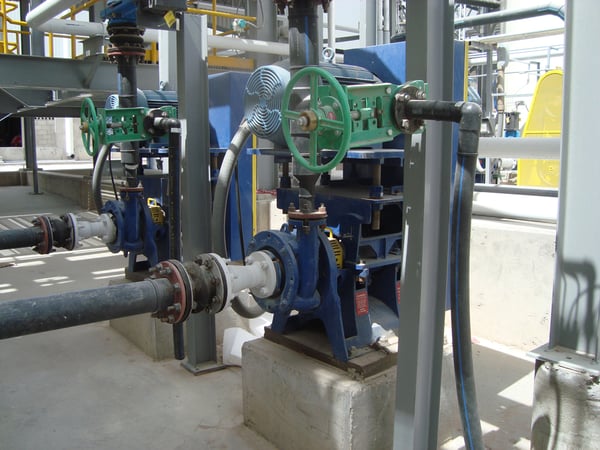
In general, the practice of “pumping through” an idle pump should be avoided. Energy is wasted and the wetted parts of the pump will still wear out, in some cases faster than a normally operating pump, due to the undesirable flow patterns caused by pumping through. In cases where this practice cannot be avoided, the following points should be remembered:
- The flow through a pump that is being “pumped through” will cause it to rotate slowly in the forward direction.
- The speed of rotation will depend on the amount of friction in the drivetrain and the flow rate going through the idle pump. The flow rate going through the idle pump is dictated by the rest of the system, i.e. the other pumps running in series and the system (pipe) characteristics. The pump speed will increase linearly with the flow rate and will depend on the amount of friction in the drivetrain. Assuming that this amounts to less than 10% of normal running torque, the pump will turn at 25% to 30% of normal running speed if the same flow rate is maintained through the system (i.e. the same flow rate is maintained as when the pump was running at full speed).
- The pressure drop across the pump under this freewheeling condition depends on the design but can be approximated using a loss coefficient (K value) of approximately five (assuming minimal drivetrain friction), for pumps with specific speeds in the range that is typical of centrifugal slurry pumps. The K value can be increased to account for drivetrain friction.
- If the rotor is locked, the pressure drop depends on the design, but can be approximated using a loss coefficient (K value) of approximately 10 for pumps with specific speeds in the range that is typical of centrifugal slurry pumps. Assuming the flow rate through the pump remains the same as when it was running at full speed, the shaft torque will increase to approximately 45% of normal running torque.
- Locking the rotor is NOT recommended, partly due to safety concerns on restart and partly due to the danger of unscrewing the impeller (see next item).
- While being pumped through, the torque on the impeller will be negative, meaning that the impeller could be unscrewed if it is not properly tightened. Therefore, it is essential that the impeller be pre-tightened. This can be accomplished by running the pump at normal speed and power before it is allowed to be “pumped through” any time the impeller is removed and replaced (or in the case of a new pump that has never run). If that is not possible, the impeller should be manually pre-tightened to 20% of the normal running torque before starting up.
Note that the unscrewing of impellers can also occur under certain conditions of back flow and reverse rotation. This subject is covered in a GIW Tech Article titled: “Reverse Rotation and Flow.”
